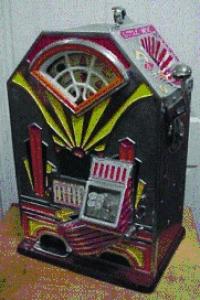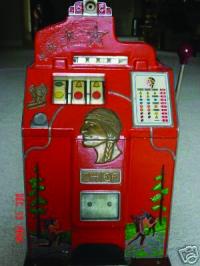
Little Duke ten cent model, made by Jennings in 1933.

4-Star Chief Prosperity 5 cent Slot Machine made by Jennings, circa 1930’s .
Rattle those bones, shooter. Eighter from Decatur. Come on big 8!
Excited words frequently spoken at a noisy, action-packed craps table inside an Atlantic City, New Jersey boardwalk casino. Located throughout this gambling hall you’d also find groups of electronic machines called a carousel. These gaming devices were usually equipped with a common denomination of betting units like quarter slots or dollar slots. Included in this maze you would encounter either low-level or sit-down slots and straight-up referring to the stand-up ones. They’re called nickel and dime slots.
Hit me and light. Double-down please. Black Jack! Busted! Phrases commonly heard while passing by a crowded $5.00 Black Jack table in a brightly lit Las Vegas, Nevada casino. Continuing on you’d catch hit the orphans or column time on the line as anxious players and curious spectators scanned the next random spin on the Roulette wheel.
Anticipation is building right here in Worcester County. Within a few miles from both Ocean City and Berlin, local folks and seasonal tourists are now able to legally tackle those automatic push-button one-arm bandits which resemble high-tech video games. The Casino at Ocean Downs has recently opened its doors and welcomes those who feel lucky. However, this isn’t the first time that games of chance played for cash prevailed in this area.
Beginning with the start of the Great Depression and approaching the peak of Prohibition in 1930, up to and including the season of 1951, Ocean City had their own gambling dens. From poker tables to slot machines with a few bingo parlors thrown in, folks had a choice of where and what to play, and it was all illegal. Some of these establishments were actually speakeasy clubs and saloons which sold illegal homemade beer and white lightning whiskey during Prohibition (1919-1933) and even offered some gaming events as an extra. Off-track betting, slots and walled crap tables were available to those who risked both reputation and cash. Entrance would only be gained by a secret set of knocks, a specific handshake or through whispered password phrases issued daily.
Incidentally, the demand for illegal alcohol (most of which came from Canada and a bit from Mexico) led to the arrest of 32 Ocean City residents and four alleged ring leaders in a smuggling conspiracy uncovered in late December 1929. Six trucks, four motor boats and 1,850 cases of intoxicating liquors were seized by the Coast Guard. Bail was set at $50,000 each for the four ring leaders. Most of the contraband was believed to be headed for area speakeasies in Philadelphia and Camden to help celebrate the New Year. Even though the Coast Guard stood on fire-watch, some of those cases disappeared during the evening hours.
One such speakeasy or saloon, that was later converted to a licensed beer joint or road house, was known locally as the Pink House. This was the Lucky Lindy named after the famous aviator daredevil Charles Augustus Lindbergh; the same Lindbergh that parachuted out of a near fuel-empty plane flying blind at 13,000 feet over Central Illinois and landing on a barbed-wire fence in 1926. His heavy flight suit protected him from serious injury. Later on, this Lone Eagle became the first pilot to fly solo in a single-engine plane (Spirit of St. Louis) non-stop from New York City to Paris in 1927.
The Lucky Lindy was located on the ocean side of the single lane highway leading through Fenwick Island at Forty-Sixth Street. Tucked away neatly behind rolling dune grasses and scattered beach-plum trees, this lonely, brightly painted pink cottage was accessible by driving up a rutted oyster and clam shell road into a small uneven parking lot made of the same material. Former Worcester County Commissioner and ex-mayor of Ocean City Roland Fish Powell humorously recalls that cars would get stuck in those ruts after a Nor’easter. Sand drifts would fill in and the hard tires the automobiles had in the late 1920s and mid 1930s couldn’t navigate those drifts. Folks would be out pushing and shoveling to free their cars.
Once you got past the crude roads, a sense of excitement and genuine risk, very close to an adrenaline rush, would take hold. Yet behind that pink-stained veneer of tranquility lurked a den of iniquity beyond the reaches of city control. According to local historian and accomplished author George M. Hurley, some adventurous folks, after entering the Lucky Lindy, were never heard from again!
Soon other areas of Ocean City became part of the gambling circuit. However, strict competition for the Depression-era dollar as well as the relaxed atmosphere for consumption of alcohol eventually took its toll on the Lucky Lindy. It ceased operating by the start of World War II.
By 1938, numerous businesses, mostly boardwalk hotel bars, restaurants, and night clubs had acquired the necessary federal stamps or permits for purchasing alcohol as well as paying for county and city licenses to operate. For these licensees it usually meant offering more than just a place to sleep or eat. Most hotels began to strategically place slot machines where they might get the most play. Some restaurants, both on and off the boardwalk, soon followed suit. In addition, the beer and bookie joints took it a step further.
Such enterprises as The Brass Rail, Sandbar Lounge, 21-Club, and Rick’s Raft began to accommodate the gambler with more than just placing bets on horses and pulling slot handles. They diversified by adding poker & black jack tables, craps corners, and roulette wheels, and each designed to give the house a bigger split.
The Brass Rail was located just a few blocks south of the old Lucky Lindy on the west side of 45th Street. While the Sandbar Lounge operated near 33rd Street bay side, and was owned by the popular Samuel Sammy C. Adams, whose sudden and mysterious death on August 30, 1946, at the age of 32, would eventually be ruled a heart attack induced by a careless mixture of medicines. He also owned the crowd-pleasing Surf Club on Eighth Street and the boardwalk in Ocean City. Adams left a wife and child as well as his mother behind.
The most notorious club which had experienced numerous police raids and, according to Frances Mumford, one of its former neighbors, occasional gunshots was Rick’s Raft. This very popular, action-packed tavern was located at 17th Street where the CVS Pharmacy is now. Its main owner was Charles A. Charlie Rickards of Bishopville and the manager was Frank Darrow.
For those untutored mavericks who were just curious, they could be found simply playing selected penny and nickel slots in the hotel lobbies stretching the length of the boardwalk, while others more learned in the art of hustling scrambled about searching for the best action. These folks could be found at the crowded Beach Club and Casino on 9th Street and the boardwalk operated by the Jackson family. Live Jazz music on special occasions could be heard coming from inside, enticing those walking by on the boardwalk.
If a hotel or restaurant needed an extra slot machine or two, they could easily go through certain channels including the Jackson clan to secure it. In turn, the Jacksons could order more replacement slots from either Pocomoke’s Brantley Watkins, owner of the famous Cheaspeake Club in that city, or local front-men William Sidney Sid Timmons or Elbridge Davis Tilghman. Tilghman’s father, Charles E. Tilghman, had owned and operated Tilly’s Amusement Pier located in Public Landing a few miles from Snow Hill. Master machinist Lewis Birch was on call for repairing jammed slots.
For the slot enthusiast, they could easily spot these machines in the following places: Colonial Hotel, George Washington Hotel, Royalton Hotel, Maryland Inn, Roosevelt Hotel, Showell’s Boardwalk Arcade, Stanley S. Ludlum’s Hotel Essex (which used to be called the Idylewild) on First Street, Marty’s Playland and the famous Atlantic Hotel operated by the Purnell family. It was reported that the fancy George Washington Hotel on Tenth Street was partially constructed in 1924 using laundered funds generated by the gangster and ruler of the Bootleg Empire, Alphonse Al Capone.
Intrigued? Tune in the next issue, March 11, for Part Two.
«Go back to the previous page.

